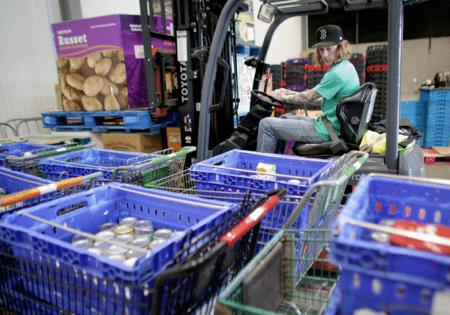'It's in a chaotic state': Virginia food banks feel the effects of federal funding cuts
Published in News & Features
Bob Latvis knows there may often be changes in federal funding for food banks with any new administration. This time though, many Virginia food banks are in a state of limbo as they wait for federal support.
The first Trump administration provided trade mitigations that increased available food for food banks, and the Biden administration provided Commodity Credit Corporation funds to help food banks purchase and distribute resources. However, roughly $500 million in commodity credit funding was cut in March, $200,000 of which was headed for the Virginia Peninsula Food Bank.
More than a third of the Peninsula Food Bank’s funding comes from federal programs, according to Latvis, who is the food bank’s chief executive officer. Roughly 80% of that comes through recently cut commodity credit, with the rest coming through The Emergency Food Assistance Program, a recurring program which is up for renewal in September’s farm bill.
“That’s the big thing, that there’s so much ambiguity and uncertainty that it’s in a chaotic state,” Latvis said.
That cut resulted in six truckloads containing lean proteins and dairy suddenly being canceled last month, Latvis said. That’s in a community where about 20% of children on the Peninsula are unsure where their next meal is coming from, one of the highest food insecurity rates in Virginia.
The food bank’s first contingency plan would be to buy more food, according to Latvis. However, despite the food bank toting a record $2 million budget for the current fiscal year, it can’t afford to buy its way out of federal cuts. Even if it could, Latvis said he could then see the other shoe drop, where new federal programs are created and the food bank is sitting on hundreds of thousands of dollars worth of extra food that would go to waste.
While the food bank has historically been adaptive to federal changes and has not yet hit a crisis point, Latvis said if federal funding cuts continue into the foreseeable future without replacements, contingency plans can only stretch so far before people in need will start feeling the effects.
“We want to provide some confidence that we will always be here for you, it just may be less than you’re accustomed to,” Latvis said. “That’s the path that we have cut for us. There’s no way to sugarcoat it. There’s no silver bullet.”
Other contingency plans include tapping into reserve funds in the short term, as well as attempting to further prioritize donations from local partners, according to Christopher Tan, president of the Food Bank of Southeastern Virginia and the Eastern Shore. In the past few weeks, the Southeastern food bank has seen $400,000 federal dollars cut from its current fiscal budget and another $300,000 nixed from next year’s.
Despite more than 200 local partners and donors, Tan said food banks are a microcosm of other federal policies, and partners may become more cautious with their donations.
“It’s not just federal funding that we have to worry about,” Tan said. “With the ups and downs of the markets, particularly the stock market, that’s our donor base. That’s where some of our major gifts are coming from.”
Tan added the food bank feels the same stress as people in their lines when it comes to purchasing food due to price increases from inflation and tariffs.
“We have to worry about being hit as a double whammy,” Tan said. “We’re losing federal funding, and our donations may go down as well because people are waiting to see how their money is doing.”
Local food banks are also watching out for potential cuts to another key resource: the Supplemental Nutrition Assistance Program, previously known as food stamps. Some federal lawmakers have eyed making cuts to the program as part of larger budget cuts.
SNAP can provide nine meals for every one provided by a food bank, said Craig Gallaer, Peninsula Food Bank’s Chief Development Officer, meaning any cuts to it would create longer lines at food banks at a time when they are already under-resourced.
“Regardless of debates about implementation and allocation and things like that, these programs have exponentially more ability to provide meals,” Gallaer said. “Even a reduction brings more people, but certainly a heavy reduction would really strain our capacity to be able to make the difference or beat the gap.”
Last time SNAP benefits were rolled back, it was supplemental pandemic-era SNAP benefits that were reduced in 2023. Gallaer said the Peninsula Food Bank saw a 30% usage increase for people needing assistance.
This coincides with a steady rise in food bank usage since the pandemic. According to Gallaer, participation and attendance at the Peninsula Food Bank is up 15% from 2024, and has continued to grow year over year.
Gallaer said part of that continued growth is due to an erosion of stigma surrounding food bank participation. People seek independence, and many struggle to ask for help when they need it. But Gallaer said many people are closer than they might think to needing some additional support, and the past few years have made food banks a crutch for when they need it.
“The stigma was reduced somewhat because people saw many of their neighbors receiving food support, and they perhaps felt like they could go themselves,” Gallaer said. “Unfortunately, that stigma is still there, and we do try to alleviate that by presenting an atmosphere that is safe, respectful and demonstrates the respect we have for all of our neighbors.”
Whether it’s through new federal funding, donor partnerships or some unforeseen third option, Gallaer said people need support and deserve to know where their next meal is coming from. And food banks will continue to fill that gap as best they can.
“The things that we’re striking the balance of right now is being aware and cautious, and being realistic,” Gallaer said. “The cuts that have happened are real and have resulted in lost food, but the food bank is always going to remain adaptable and flexible.”
_____
©2025 The Virginian-Pilot. Visit pilotonline.com. Distributed by Tribune Content Agency, LLC.







Comments